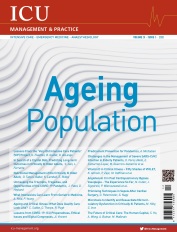Volume 20 - Issue 3, 2020
- ICU
- 14/09/2020
Change content default value
READ MORE
Professor Michael Mansour is a physician-scientist with a research concentration in immune responses against invading pathogens. He attends on the Clinical Transplant Infectious Diseases and Immunocompromised Host Service at the Massachusetts General Hospital - Division of Infectious Diseases, where he cares for solid and stem cell transplant recipients...
READ MOREAn overview of the VIP project that studies a subgroup of patients ≥ 80 years, the oldest old, since both ICU mortality and morbidity are increased with advanced age. D uring the last 10 years, we have observed an increased interest in research into our oldest intensive care patients. This is brought forward with the expectation...
READ MOREOlder adults who survive critical illness are at risk of adverse long-term outcomes, including long-term mortality and impairment in physical function, cognitive function, and mental health. In this article, we discuss the evidence behind prediction of these outcomes in older ICU survivors, and review risk factors that should be considered in...
READ MOREA review of available evidence and an overview of recommendations for the nutritional management of the critically ill older adult. Introduction Worldwide, there is a shift in the distribution of the population towards older ages. This shift is similarly being experienced in the Intensive Care Unit (ICU), with the median age of the...
READ MOREPost cardiopulmonary bypass vasoplegia is common, and associated with poor outcomes. Traditional management strategies involving escalating doses of catecholamines, vasopressin and adjuncts such as methylene blue and hydroxycobalamin or ascorbic acid have not shown promising results. Since ACE enzyme dysfunction, high serum renin and low endogenous...
READ MOREThe purpose of this article is to give an up-to-date, comprehensive review on the utilisation of extracorporeal blood purification techniques and immunostimulation in septic patients after cardiac surgery. Introduction Sepsis is a potentially life-threatening state caused by an infection and an inadequate, dysregulated host immune...
READ MOREAn overview of real-time digital assessment of microcirculation and quantification of tissue perfusion and the physiological and technical considerations that may, in the near future, change the way we look at circulatory shock in critically ill patients. The Challenges of Detecting Circulatory Shock Despite recent advances in the...
READ MOREThis article will focus on the non-clinical, human aspects of critical care, namely the patient and the ICU team. The modern concepts of humanising ICU care, the healing environment and future-proofing the ICU team will be discussed. Introduction Despite being a relatively young specialty, critical care has made remarkable progress...
READ MORESepsis and septic shock are the leading causes of death in the ICU. With an estimated mortality rate of 40-60%, septic shock is in the focus of adult critical care medicine. It is broadly accepted that intervention in the very early phase of sepsis before the complex inflammatory host response is initiated should be one major area that clinical research...
READ MORE